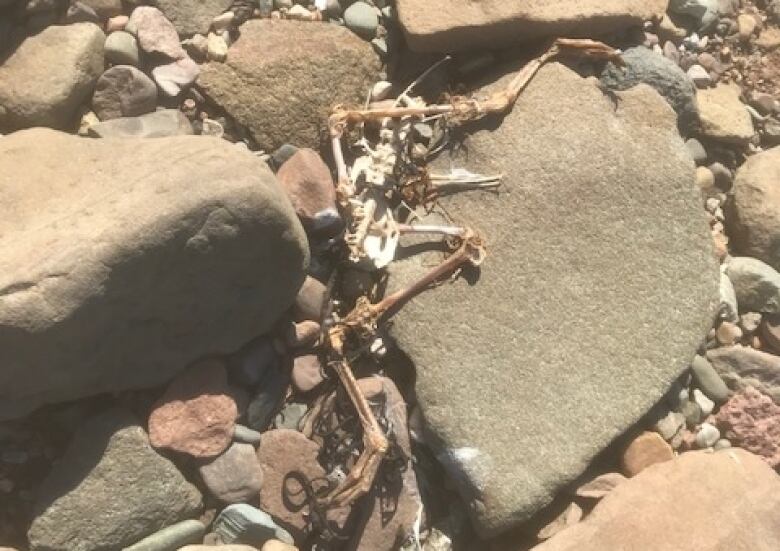Hundreds of dead gulls found as 'unprecedented' avian flu outbreak continues in Nova Scotia
Carcasses recently discovered on Bear Island near Digby

Dr. Ted Leighton visited Bear Island nearDigby, N.S.,in mid-August, andknew something was amiss when he spotted a couple of seagullsacting oddly.
"They were behaving in a way that suggested some sort of neurological disorder," said Leighton, a retired veterinary pathologistand wildlife health researcher.
He noticed something else, too.
"I could see that there was an awful lot of scavenging going on.You could see a gull or two picking away at something dead on the beach, repeated again and again and again down the straight shoreline, as I could see it. So I thought there must be some substantial mortality going on."
Leighton, aninternationally renowned scholar in wildlife disease, didn't have a chance to investigate further that day, but when he returned to Bear Island on Sept. 3, his suspicions were confirmed.
"There were skeletal remains all over the place," he said. "Often it was just wings and breastbone, no flesh at all,sometimes feathers."

Leighton said it's impossible to knowhow many seagulls died on the island recentlybecause the tides wash carcasses into the Annapolis Basin twice a day, but he saidthe number is definitely in the hundreds.
Leighton believes highly pathogenic avian influenza is to blame for the die-off.
"It'svery unlikely that it's anything else, but of course one has to do the expensive work oftesting for the virus to be sure."
Bear Island is accessible by foot at low tide and is the occasional destination of hikers andclimbers. The Town of Digby recently asked people to stay off the island.
An unprecedentedyear
Leighton collected some specimens from the island, which will be sent to the Canadian Wildlife Health Cooperative (CWHC) for testing. The cooperative, which Leighton co-founded and then headed for many years,provides disease surveillance and tracking of mortality events in wildlife across Canada.
Dr. Megan Jones, the Atlantic regional director of the CWHCand an assistant professor in the department of pathology and microbiology at the Atlantic Veterinary College,saidit's been an unprecedentedyear for avian influenza in the Atlantic provinces and across the continent.
She said normally, in the first six months of a year, the Atlantic office of the cooperative does about 300 diagnostic tests on wildlife, but this year, staff did 1,400 tests in that period. The organization has facedsuch high demand that it now has to prioritize certain cases because it's already spent its entire diagnostic budget for the year.

From January to March, about nine per cent of the tests came back positive for the highly pathogenic avian influenza, and between April and June, that number had risen to about 20 per cent.
"It's a challenge because there's really not much we can do," Jones said. "They're going to congregate,there's no social distancing,so there's not much we can really do about it besides track it and try to minimizetransmission."
Glen Parsons, the manager of the sustainable wildlife use program at Nova Scotia's Department of Natural Resources and Renewables, said the province has received reports of dead birdsin every county, and has seen cases of highly pathogenic avian influenza from Yarmouth to Sydney.
Parsons said the virus is transmitted through direct contact, including through feces and liquids, so people are advised not to touch or approach sick or dead birds and to refrain from feeding birds.
Anyone in Nova Scotia who finds a sick or dead bird or animal should call Natural Resources at 1-800-565-2224.
Tracking H5N1
North America'soutbreak of highly pathogenic avian influenza, a strain of H5N1, began in Newfoundland last December with the discovery of the virus at an exhibition farm. After that, a case cropped up in a Canada gooseinNova Scotia, and then in other birds in New Brunswick and Prince Edward Island. In the intervening months, the virus has spread throughout the continent after sweeping across Europe last year.
It has caused significant mortalities in wild bird populations, and hasbeen found in foxes in Nova Scotia and Prince Edward Island as well as harbour seals in Quebec. In other parts of Canada and the U.S., it has been found in skunks, raccoons and bobcats, Jones said.

This particular strain of H5N1has not caused significant disease in humans, but public health officials closely track any cases, as transmission of the virus to humans could cause a global outbreak.
The CWHC sends samples of all positive cases in wildlife to theNational Centre for Foreign Animal Diseaseslab in Winnipeg that does genetic sequencing of the virus to try to catch any mutations that may make it more likely to infect people.












_(720p).jpg)


 OFFICIAL HD MUSIC VIDEO.jpg)
.jpg)



























































































